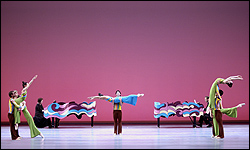It may be an odd comment to make about a dancer, but Noelani Pantastico is great at standing still. Not long into Christopher Stowell’s new Quick Time, after Jonathan Poretta has swaggered and bounced across the stage to Camille Saint-Saëns’ Variations on a Theme of Beethoven, Pantastico paces confidently to center stage during Pacific Northwest Ballet’s “American Choreographers” program (through Sunday, April 24, at McCaw Hall; 206-441-2424) and waits calmly for her turn to dance. Where Poretta has been all swinging arms and attitude, Pantastico is more deliberate and placid, an odalisque in a mod turquoise jumpsuit. Even when she’s zipping through some twisty sequences, changing direction and shape on almost every beat, she still has a kind of model’s hauteur, a sense of stillness and repose that gives the audience an anchor throughout the ongoing quirkiness of Stowell’s choreography.
Quick Time is a tribute to Stowell’s parents—departing PNB artistic directors Kent Stowell and Francia Russell— and laced full of intentionally whimsical touches, from multicolored “slipcovers” for the two onstage pianos to recurring beach motifs (preening in the sun, flutter kicking) in the movement. These playful touches are charming but can get in the way of the central thread of the ballet, as Pantastico and Poretta move beyond their signature stereotypes to a more direct kind of dance communication. Eventually, we begin to wonder what we would see without the Emilio Pucci–inspired costumes and clever lighting cues; underneath all that, there seems to be a substantial ballet, but it’s hard to know for sure.
When PNB was putting together the lineup for this program last year, it originally included Stowell’s 2003 orchestral piece Zaïs, while Paul Gibson had probably not yet decided on music for his new work, so it may be an unintentional coincidence that they both chose piano scores. For The Piano Dance, Gibson has stitched together a wide variety of composers, with ballet stalwart Frederick Chopin nestled among more unusual choices Bela Bartok, John Cage, Alberto Ginastera, and Gyorgy Ligeti. Gibson makes good use of these distinct styles, creating brief and intense dances that draw powerfully from his neoclassical heritage, especially the works of George Balanchine, who is “quoted” several times throughout the ballet. Although this isn’t a dance specifically about relationships, Gibson returns over and over to the dynamics of those connections, in which one person might lead and the other follow—including one chilling duet with Casey Herd and Lesley Rausch where she begins draped over his shoulder and ends with arms and legs splayed wide, like a carnivorous insect attached to his legs.
Many ballet companies perform José Limón’s 1949 modern dance classic The Moor’s Pavane, but this quartet, based on Othello,is trickier than it might at first seem. Much of what is central to Limón’s style—the powerful use of weight and the way he revealed the effort in his movement—is antithetical to traditional ballet technique. PNB’s production of the work comes close to the visceral dynamic of the original style, but the contemporary cast, with its 21st-century technique, sometimes loses the sense of tension that underlies the dance. For Limón’s generation, the physical challenge of the choreography reinforced the drama; newer dancers need to find other ways to create that effect.
Val Caniparoli’s Lambarena is a different kind of task, combining the mobile spine and swinging hips of African dance with classical ballet. The company has performed this several times in the past, and its ability to blend those elements has deepened with each repetition. The stage is full of excellent dancing, but Carrie Imler stands out in the central woman’s role: Self-reliant as well as sinuous, she makes easy work of the complex polyrhythms, and as she summons other dancers to the stage, she draws in the audience as well. It’s a buoyant conclusion to a program that takes on big challenges from the wild variety of American ballet.








